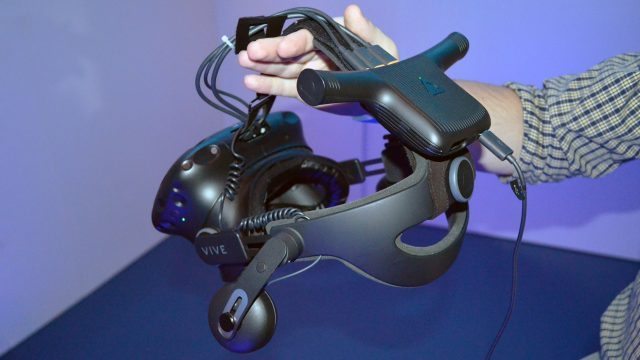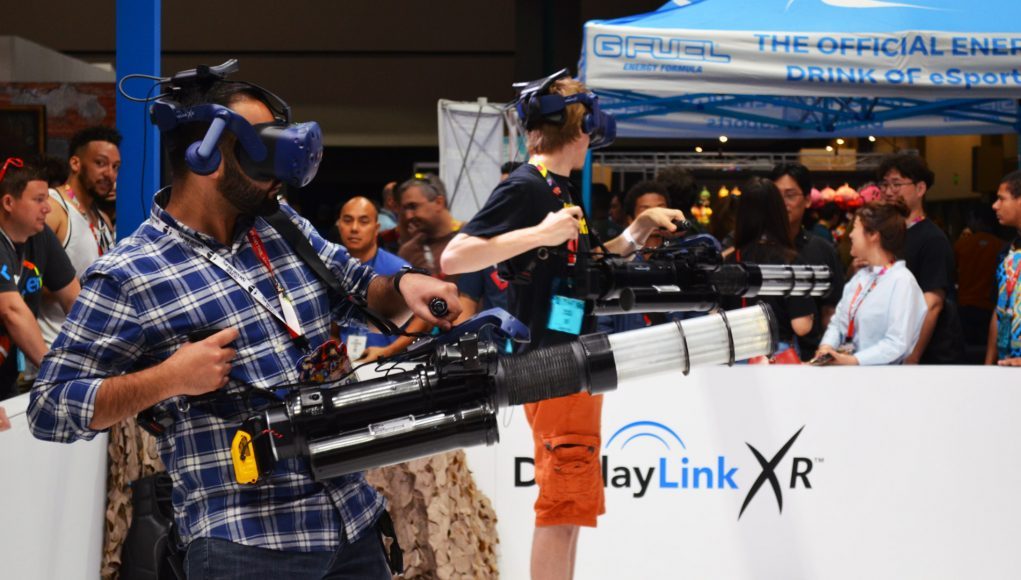After revealing the Vive Wireless Adapter earlier this year, the company confirmed this week at E3 2018 that the device is on track to launch by late Summer, and offered up some details on the device’s battery and operation. I went hands-on with a near-final version and came away impressed.
Update (June 20, 2018): After some technical difficulties were sorted out at DisplayLink’s E3 booth, I got to go hands-on with a near-final version of the Vive Wireless Adapter and came away impressed.
The adapter was being shown paired with a Vive Pro, along with a big gatling gun controller custom-made to work with Serious Sam VR: The Last Hope (2017). While the chosen demo was something of a best-base-scenario for the adapter (players are stationary, the virtual scene is very bright, particle effects are minimal), at least in this case the performance was very impressive, showing sharp visuals that looked indiscernible from what would be seen on a wired headset, along with perfect tracking, also not noticeably different than what I’m used to seeing on a wired headset. While I had noticed some slight latency back when I tried the Vive Wireless Adapter at CES at its introduction earlier this year, this time around I didn’t see any added latency. When I asked about the latency in the CES demo, DisplayLink said there may have been an issue with that demo relating to the lighting in the room, which has caused them issues in the past.
In addition to no noticeable latency, the system was also very robust in my demo—I didn’t see a single frame drop, tracking issue, or any other major artifact from the Vive Wireless Adapter, which bodes well for consistent performance. The only artifact I was able to spot was a slight blockiness in the view when quickly rotating my head back and forth, but I had to look very carefully for this and I think it will go unnoticed by the vast majority of users.
I’m still interested to see how the Vive Wireless Adapter holds up in more challenging situations (highly active games, scenes which are more difficult for compression, etc), but from my experiences thus far, it appears to be shaping up to be a promising wireless solution, even for the higher resolution of the Vive Pro.
Original Article (June 12, 2018): Showing off the Vive Wireless Adapter with the Vive Pro at the DisplayLink booth at E3 2018, an HTC spokesperson said that the unit is nearing production readiness and is on track to launch by late Summer. The battery that will ship with the unit, powering both the adapter and the Vive headset, is the QC 3.0 Powerbank that HTC presently sells as an accessory; its expected to offer two to three hours of battery life, and take about one hour to reach a full charge. Since the power output on the battery is a simple USB port, it seems likely that users could use any off-the-shelf powerbank, but the company hasn’t confirmed that capability just yet.

HTC also said that up to three Vive Wireless Adapters can be used in the same space without interference issues (each requiring their own transmitter, by my understanding), and that the ideal range of the system is up to six meters from the transmitter.
The price of the Vive Wireless Adapter hasn’t been confirmed, but the ~$300 pricetag of the third-party TPCast wireless solution [Amazon] gives us a rough hint of where things might fall. Granted, HTC is likely to target the Wireless Adapter mostly at less price conscious commercial and enterprise users, and thus we may see a more premium price, much like the Vive Pro.
At the DisplayLink booth the company is showing off the Vive Pro with the Vive Wireless Adapter, and a custom-built gatling gun controller made to show Serious Sam VR: The Last Hope (2017) at the booth. Today, the first day of E3, they were having some technical issues with the gun and so I haven’t yet had a chance to go hands-on with the latest version of the Vive Wireless Adapter, but expect to soon. [See update above]
I did however have a chance to speak with DisplayLink’s Andy Davis, Director of Marketing, and ask him about my CES hands on with the Vive Wireless Adapter where I noted impressive robustness, but a bit of latency too (which was surprising because I didn’t see such latency on an earlier reference design that I tried). Davis told me that either the game or the room’s lighting may have been impacting the latency at the CES demo, and he didn’t believe that the adapter was part of the issue. Further, he said that the current setup at E3 shouldn’t have any issues with lighting, so I’m looking forward to giving it another go to find out how it handles under more controlled conditions. [See update above]
Update (6/12/18): An HTC spokesperson reached out to say that the originally quoted figure of a maximum of six wireless adapters functioning together in one space was stated in error, and that the maximum supported in one space is three. This has been adjusted in the article above.







